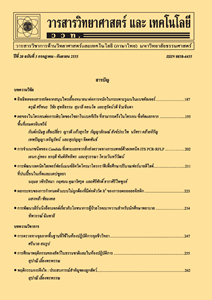ลักษณะทางสัณฐานวิทยาของเส้นใยนาโนบริโภคได้จากสารผสมไคโตแซน-เซลลูโลสอะซิเตท-เจลาตินเสริมน้ำมันหอมระเหยยูจีนอล โดยวิธีปั่น และปั่น-พ่นด้วยไฟฟ้าสถิต
Main Article Content
Abstract
The objective of this research was to investigate the morphology of edible electrospun chitosan-cellulose acetate-gelatin blended nanofibers fortified with eugenol by electrospinning and electrospinning-spraying technique. For the preparation of fortified eugenol electrospun nanofiber mats, eugenol (0, 1.5 and 3.0 %) was incorporated into chitosan-cellulose acetate- gelatin solutions which were successfully electrospun into mats with average fiber diameters 152.32±41.47, 232.63±104.97 and 246.05±84.36 nm respectively. The fiber diameters increased by increasing the concentration of eugenol. In addition, the smooth and continuous uniform nanofibers were obtained without eugenol formulated while larger fiber diameter with junction was obtained at the concentration of eugenol of 1.5 and 3.0 %. For the fortification of eugenol by electrospraying, electrospun nanofiber mats were rough due to the eugenol droplet attached on the surface of chitosan-cellulose acetate-gelatin nanofibers when incorporated at 1.5 and 3.0 %. Spraying with the eugenol at 1.5 % showed the average droplet diameters of 225.96±171.14 nm and the average droplet diameters decreased to 156.90±134.42 nm when the concentration of eugenol in sprayed solution was increased to 3.0 %. However, the releasing profile, the antimicrobial activity and physical properties of electrospun nanofiber mats should be further investigated before various application such as wound dressing, tissue scaffolding, drug delivery and food packaging.
Keywords: electrospinning; electrospraying; nanofibers; eugenol
Article Details
References
[2] Blanco-Padilla, A., Soto, K.M., Iturriaga, M.H. and Mendoza, S., 2014, Food antimicrobials nanocarriersม Sci. World J. 2014: 1-11.
[3] Bhushani, J.A. and Anandharakrishnan, C., 2014, Electrospinning and electrospraying techniques: Potential food based applications, Tren. Food Sci. Technol. 38: 21-33.
[4] Oraby, M.A., Waley, A.I., El-Dewany, A.I., Saad, E.A. and Abd El-Hady, B.M., 2013, Electrospun gelatin nanofibers: Effect of gelatin concentration on morphology and fiber diameters, J. Appl. Sci. Res. 9: 534-540.
[5] Rogina, A., 2014, Electrospinning process: Versatile preparation method for biodegradable and natural polymers and biocomposite systems applied in tissue engineering and drug delivery, Appl. Surf. Sci. 296: 221-230.
[6] Erdem, R., Usta, I., Akalin, M., Atak, O.,Yuksek, M. and Pars, A., 2014, The impact of solvent type and mixing ratios of solvents on the properties of polyurethane based electrospun nanofibers, Appl. Surf. Sci. 334: 227-230.
[7] Lacroix, M.R. and Pellerin, C., 2013, Molecular orientation in electrospun fibers: From mats to single fibers, Macromolecules 46: 9473-9493.
[8] Zargham, S., Bazgir, S., Tavakoli, A., Rashidi, A.S. and Damerchely, R., 2012, The effect of flow rate on morphology and deposition area of electrospun nylon 6 nanofiber, J. Eng. Fiber. Fabr. 7: 42-49.
[9] Li, Z. and Wang, C., 2013, Effects of Working Parameters on Electrospinning, pp. 15-28, Chpt. 2 in One-Dimensional Nanostructures: Electrospinning Technique and Unique Nanofibers, Springer Briefs in Materials.
[10] Santos, C., Silva, C.J., Büttel, Z., Guimarães, R., Pereira, S.B., Tamagnini, P. and Zille, A., 2014, Preparation and characterization of polysaccharide/PVA blend nanofibrous membranes by electrospinning method, Carbohyd. Polym. 99: 584-592.
[11] Sener, A.G., Altay, A.S. and Altay, F., 2011, Effect of voltage on morphology of electrospun nanofibers, pp. I-324 - I-328, 7th International Conference on Electrical and Electronics Engineering (ELECO), Bursa.
[12] Rieger, K.A. and Schiffman, J.D., 2014, Electrospinning an essential oil: Cinnamaldehyde enhances the antimicrobial efficacy of chitosan/poly (ethylene oxide) nanofibers, Carbohyd. Polym. 113: 561-568.
[13] Venkatesan, J., Kim, S.W. and Wong, T.W., 2015, Chitosan and its application as tissue engineering scaffolds, pp. 133-147, In Nanotechnology Applications for Tissue Engineering, Elsevier, Inc.
[14] Geng, X., Kwon, O.H. and Jang, J., 2005, Electrospinning of chitosan dissolved in concentrated acetic acid solution, Biomaterials 26: 5427-5432.
[15] Huang, Z.M., Zhang, Y.Z., Ramakrishna, S. and Lim, C.T., 2004, Electrospinning and mechanical characterization of gelatin nanofibers, Polymer 45: 5361-5368.
[16] Choktaweesap, N., Arayanarakul, K., Aht-ong, D., Meechaisue, C. and Supaphol, P., 2007, Electrospun gelatin fibers: Effect of solvent system on morphology and fiber diameters, Polym. J. 39: 622-631.
[17] Khalili, S., Khorasani, S.N., Saadatkish, N. and Khoshakhlagh, K., 2016, Chracteri-zation of gelatin/cellulose acetate nanofibrous scaffolds: Prediction and optimization by response surface methodology and artificial neural networks, Polym. Sci. 58: 399-408.
[18] Fischer, S., Thummler, K., Volkert, B., Hettrich, K., Schmidt, I. and Fischer, K., 2008, Properties and applications of cellulose acetate, Macromol. Symp. 262: 89-96.
[19] Dhandayuthapani, B., Krishnan, U.M. and Sethuraman, S., 2010, Fabrication and characterization of chitosan-gelatin blend nanofibers for skin tissue engineering, J. Biomed. Mater. Res. B Appl. Biomater. 94B: 264-272.
[20] Haider, S., Al-Masry, W.A., Bukhari, N. and Javid, M., 2010, Preparation of the chitosan containing nanofibers by electro-spinning chitosan-gelatin complexes, Polym. Eng. Sci. 50: 1887-1893.
[21] Vatankhah, E., Prabhakaran, M.P., Jin, G., Mobarakeh, L.G. and Ramakrishna, S., 2014, Development of nanofibrous cellulose acetate/gelatin skin substitutes for variety wound treatment applications, J. Biomater. Appl. 28: 909-921.
[22] Ali, S. M., Khan, A. A., Ahmed, I., Musaddiq, M., Ahmed, K. S., Polasa, H., Rao,L.V., Habibullah, C.M., Sechi, L.A. and Ahmed, N., 2005. Antimicrobial activities of eugenol and cinnamaldehyde against the human gastric pathogen Helicobacter pylori, Ann. Clin. Microbiol. Antimicrob. 4: 20.
[23] Devi, K.P., Nisha, S.A., Sakthivel, R. and Pandian, S.K., 2010. Eugenol (an essential oil of clove) acts as an antibacterial agent against Salmonella typhi by disrupting the cellular membrane, J. Ethnopharmacol. 130: 107-115.
[24] Marchese, A., Barbieri, R., Coppo, E., Orhan, I.E., Daglia, M., Nabavi, S.F., Izadi, M., Abdollahi, M., Nabavi, S.M. and Ajami, M., 2017. Antimicrobial activity of eugenol and essential oils containing eugenol: A mechanistic viewpoint, J. Crit. Rev. Microbiol. 43: 668-689.
[25] Yuan, X., Zhang, Y., Dong, C. and Sheng, J., 2004, Morphology of ultrafine polysulfone fibers prepared by electrospinning, Polym. Int. 53: 1704-1710.
[26] Baji, A., Mai, Y.W., Wong, S.C., Abtahi, M. and Chen, P., 2010, Electrospinning of polymer nanofibers: Effects on oriented morphology, structures and tensile properties, Comp. Sci. Technol. 70: 703-718.
[27] Vitchuli, N., Shi, Q., Nowak, J., Kay, K., Caldwell, J.M., Breidt, F., Bourham, M., McCold, M. and Zhang, X., 2011, Multifunctional ZnO/Nylon 6 nanofiber mats by an electrospinning-electrospraying hybrid process for use in protective applications, Sci. Technol. Adv. Mater. 12: 1-7.


